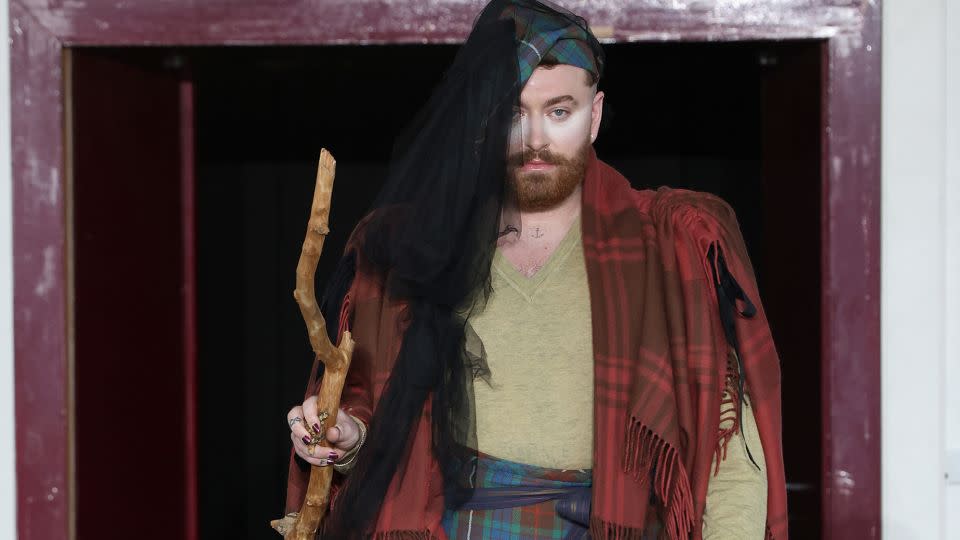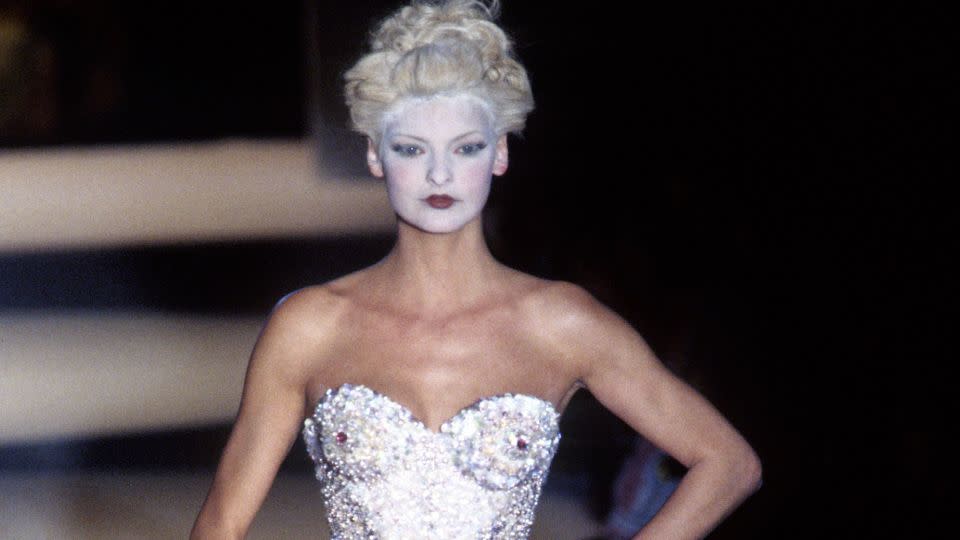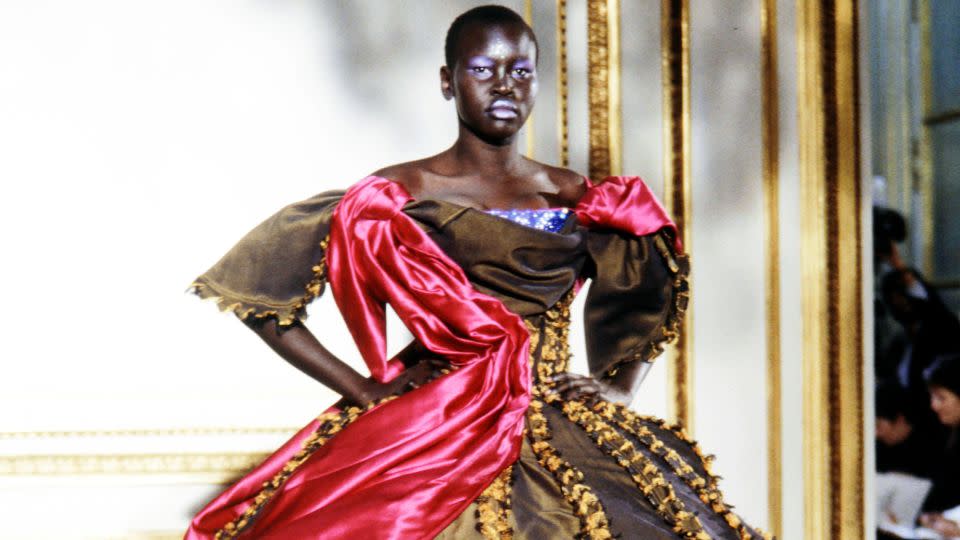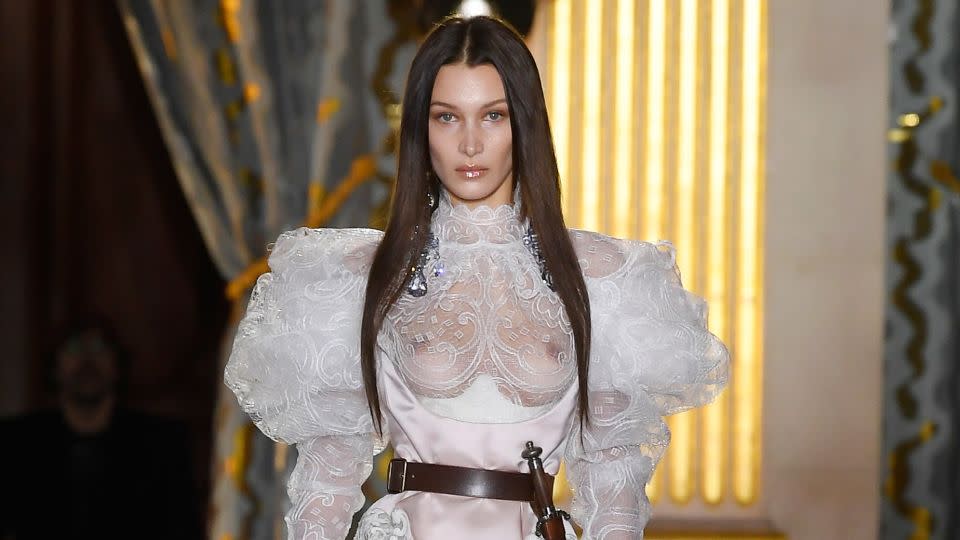What happens when a fashion house outlives its founder?
- Oops!Something went wrong.Please try again later.
Editor’s Note: Featuring the good, the bad and the ugly, ‘Look of the Week’ is a regular series dedicated to unpacking the most talked about outfit of the last seven days
It began with a bellowing horn. Then out came singer Sam Smith, trudging onto the catwalk wearing a tartan shawl shrugged over a v-neck jumper and a functional codpiece-turned-fanny-pack. On their head, another ream of tartan was twisted with black tulle that, from a distance, resembled a flowing mass of dark knotted hair. Trouserless, Smith’s look was finished off with a pair of towering, tartan platform boots and a gnarled wooden walking staff.
Were we watching an amateur rendition of Mel Gibson’s “Braveheart”? Apparently not. The discombobulating outfit was, in fact, the opening look of Vivienne Westwood’s Fall-Winter 2024 show in Paris — a collection that has proved divisive online.
Designed by Andreas Kronthaler, the late Westwood’s co-collaborator since 1990 and husband since 1992, this season felt like a departure from a more popular version of the brand. In truth, many elements of a traditional Westwood show were there — the high platform shoe, the reference to 18th and 19th century dress, an irreverent glimpse of a butt cheek, even the codpieces seemed to be a nod to the brand’s history pioneering of underwear as outerwear in the 1980s. But the execution was jumbled and confused, a sentiment that was neatly — and perhaps unfortunately — summarized in Smith’s outfit.

Vivienne Westwood, who died in December 2022, has long been recognized as a vanguard of the fashion industry — pushing the boundaries of what was acceptable, even at times what was wearable, and using her platform to amplify discussions on climate change and over-consumption. Her designs have influenced fashion’s greats from Alexander McQueen to John Galliano, and the label has even enjoyed a recent revival amongst Gen Z (so popular is the Vivienne Westwood 1990 “orb choker,” there are now hundreds of counterfeits available on Temu, AliExpress and Etsy).
Knowing that many feel passionately about the brand, particularly after Westwood’s death, the show on Saturday appeared to touch a nerve. “Vivienne Westwood will be turning in her grave watching Sam Smith in this get up,” wrote one disgruntled fan on X. “I cannot believe this is a Vivienne Westwood show,” chimed another. While many online lamented how Kronthaler’s latest season has “defiled” and “tainted” Westwood’s fashion reputation.

In reality, Kronthaler has played an important role in building Westwood’s legacy. From the time Kate Moss walked the runway in little more than a captain’s hat eating a chocolate ice cream, Kronthaler was there, and his vision is inextricable from the DNA of Westwood.
But perhaps the label works best when the garish is balanced with the glamorous. The punk designer has always been, as Vogue wrote, “confrontationally subversive” but she was also a tailor who understood the power of proportion, silhouette, shape. For every oversized t-shirt Westwood sent down the runway scrawled in Sharpie pen, there were 10 truly transcendent looks banked in her arsenal.

There was the opulent, crystal-encrusted corset dress Linda Evangelista wore for the Fall-Winter 1995 show, the chiseled bodice enchantingly offset by the soft, ombré ostrich feather skirt. Or the regal satin ball gowns and sleek, sexy skirt suits of Spring-Summer 1998, two sides of the same Westwood archetype that could somehow happily coexist on one runway. Kronthaler has proved he can do this, too. Just take the closing look of Fall-Winter 2020 (his debut solo collection). Bella Hadid is reimagined as a Renaissance princess in translucent white lace, puff-sleeves, a pink satin corset and a brown leather belt with a matching sword and sheath.
After all, there are so many variations of what “Vivienne Westwood” means — the brand has existed for over 50 years. To one person, true Westwood means draped dresses and exaggerated corsetry. To another, it’s ripped stockings, bare butts and bikini bottoms.

When a fashion house outlives its founder, scrutiny is often magnified by nostalgia. But the furore is unlikely to faze Kronthaler. “I of course noticed this wave — this phenomenon,” he told the Financial Times in 2022, when asked about the renewed interest in the Westwood brand. “But I’m ducking under it, trying not to get too engaged. I don’t want to make a parody — reworking, redoing it.”
“And it’s not my nature either, looking back,” he said.
For more CNN news and newsletters create an account at CNN.com

